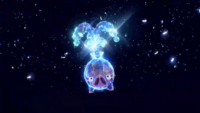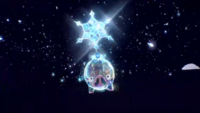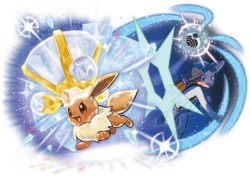Terastal phenomenon

|
This article is incomplete. Please feel free to edit this article to add missing information and complete it. Reason: TCG details |
The Terastal phenomenon (Japanese: テラスタル Terastal) is a temporary transformation affecting Pokémon that was introduced in Generation IX. This transformation gives the Pokémon a gem-like appearance along with changing into the exclusive Tera Type (Japanese: テラスタイプ Teras-Type).
History
There is a lot of mystery surrounding the Terastal phenomenon and why it only happens in Paldea. Professor SadaS/Professor TuroV was known to be researching this mysterious transformation.[1]
The Terastal phenomenon was first discovered 140 years ago in Area Zero along with Terastallized Pokémon at the bottom of the Great Crater of Paldea. However, attempts to remove Terastallized Pokémon from the crater caused the light to disappear. Further details of the Terastal phenomenon thus remained unclear for a while.
Ten years before the events of Pokémon Scarlet and Violet, the game's professor started to solve the mystery. The professor discovered the energy emitted from shining crystals in Area Zero is what triggered the Terastal phenomenon. The Tera Orbs were then created by the professor from the Terastal energy located in Area Zero. Clavell helped support the research on it. This allowed people to Terastallize their Pokémon outside of Area Zero. The Tera Orb was then shared to the Paldea League and Naranja AcademyS/Uva AcademyV.
At some point, the Terastal energy was used by the professor to create a time machine, bringing in Paradox Pokémon from the ancient pastS/distant futureV, including a pair of KoraidonS/MiraidonV.
The crystalline petals of Glimmora seem to resemble the Tera Jewels that appear during the Terastal phenomenon. It is unknown if there is a connection between Glimmora and the Terastal phenomenon, though many of them (along with its pre-evolution, Glimmet) can be found in Area Zero, the place where the phenomenon originated. Additionally, eight Glimmet Crystals are needed to make TM171 (Tera Blast), a move that changes type with Terastalizing.
The Scarlet Book/Violet Book makes cryptic hints that it may be linked to an unknown Pokémon resembling a disk made of layers of overlapping hexagons, but the truth of this has yet to be confirmed. A journal in Research Station No. 1 further implies its existence and relationship to the phenomenon. The journal reads, "We've determined that this energy crystallization is linked to the being we call ▊▊▊▊▊▊. The interlocking hexagonal plates that comprise ▊▊▊▊▊▊'s shell must somehow cause this phenomenon—which I've dubbed 'Terastallizing.'" This Pokémon is likely to be Terapagos, based on its description.
Effects
Trainers who obtain a Tera Orb are able to use it to Terastallize their Pokémon, which makes a Tera Jewel appear above the Pokémon's head, causes the Pokémon's body to glisten like gems. This changes the Pokémon's defensive type(s) to its Tera Type, removing all other types. Terastallized Pokémon are identified by having "Tera" in front of their name.
While Terastallized, Pokémon receive STAB on moves matching their Tera Type, in addition to moves matching the type(s) they had immediately before Terastallizing. If the Pokémon's Tera Type is the same as one of its original types, moves of that type receive an ×2 power boost instead of the usual ×1.5.[1]
During this time, Adaptability only works for the Tera Type (with ×1.5 becoming ×2 and ×2 becoming ×2.25). Additionally, moves of the Tera Type that have base power below 60 but are not a multi-strike move or an increased priority move are stealthily boosted to 60BP; this is checked for after Technician's boost.[2] Pokémon can only have one Tera Type. The move Tera Blast changes type to the Pokémon's innate Tera Type upon Terastallization.[3]
Terastallized Pokémon cannot have their type changed from moves and Abilities such as Soak, Double Shock, and Protean. A Pokémon using Transform will not copy its opponent's Tera Type and will instead keep its own. Additionally, if a Pokémon Terastallizes and then uses Transform, they will appear to lose their Tera Jewel but retain the crystalline body texture.
The Terastal phenomenon lasts until the battle ends or the Terastallized Pokémon faints. After being used once, the Tera Orb loses all its Terastal energy and has to be recharged by either touching crystals containing Terastal energy or visiting a Pokémon Center.[1] An exception to this can be found in Area Zero, where the Tera Orb will automatically recharge each time it is used.
After beating the Medali Gym, the player can change their Pokémon's Tera Type at the Treasure Eatery by exchanging 50 Tera Shards of a given type with the chef.
The phenomenon is only found in Paldea, apparently due to the Terastal energy seeping from the ground of the region.[1]
Catching Tera Pokémon
Normal wild Pokémon found in Paldea typically have a Tera Type that matches one of their normal types. This Tera Type does not reflect their potential evolutions and cannot be passed down through breeding. For example, a Charcadet will always have a Fire Tera Type. Typically, there are only two ways to obtain a wild Tera Pokémon with unique typing: either catch a wild Tera Pokémon scattered around Paldea, or participate in a Tera Raid Battle. These Pokémon may know TM moves that match this set Tera Type.
Wild Tera Pokémon
There are precisely 68 wild Tera Pokémon scattered around Paldea, the majority with unique Tera Types. They can be found in fixed locations and typically have Tera Types different from their base types, a notable exception being the eight Eeveelutions, who have Tera Types that match their base types, and would normally have a Normal Tera Type if evolved from Eevee. The wild Tera Pokémon are indicated by a bright glow emitting from their bodies, and when battled against will immediately Terastallize. Wild Tera Pokémon cannot be caught while Terastallized until after they lose their Terastallization, which will happen after sustaining a certain amount of damage from direct attacks. Once this threshold is reached, the damage the Pokémon has taken will be capped until they lose their Terastallization.
Tera Raid Battle
Tera Raid Battles occur all over Paldea, with the locations changing at random each real-life day at midnight. These locations are indicated on the map, and in the overworld are indicated by a large, colored "shining crystal", with a beam of sparkling lights shooting into the sky.
Tera Jewels
| Type | Image | Description |
|---|---|---|
| Normal | 
|
The Normal-type Tera Jewel is based on a diamond ring, or possibly a Normal Gem. |
| Fighting | 
|
The Fighting-type Tera Jewel is based on a large fist, similar to Max Knuckle |
| Flying | 
|
The Flying-type Tera Jewel is based on a cluster of balloons, a possible reference to Flying Pikachu (which is further supported by the fact that a Flying Tera Type Pikachu has been distributed as a Mystery Gift). |
| Poison | 
|
The Poison-type Tera Jewel is based on the stereotypical warning sign for toxic objects and real-life poisons, a skull and crossbones. |
| Ground | 
|
The Ground-type Tera Jewel is based on a cut-through model of the Earth. |
| Rock | 
|
The Rock-type Tera Jewel is based on the Acropolis of Athens. |
| Bug | 
|
The Bug-type Tera Jewel is based on the wings and antennae of an insect. |
| Ghost | 
|
The Ghost-type Tera Jewel is based on the Generation I sprite of a ghost. |
| Steel |  
|
The Steel-type Tera Jewel is based on a single-bladed axe. |
| Fire | 
|
The Fire-type Tera Jewel is based on a candelabra or chandelier. |
| Water | 
|
The Water-type Tera Jewel is based on a water fountain. |
| Grass | 
|
The Grass-type Tera Jewel is based on a bouquet of flowers. |
| Electric | 
|
The Electric-type Tera Jewel is based on a lightbulb. |
| Psychic | 
|
The Psychic-type Tera Jewel is based on an eye, resembling the type's TCG type symbol. |
| Ice | 
|
The Ice-type Tera Jewel is based on a snowflake. |
| Dragon | 
|
The Dragon-type Tera Jewel is based on the head and wings of a dragon. |
| Dark | 
|
The Dark-type Tera Jewel is based on a face with a mischievous grin. |
| Fairy | 
|
The Fairy-type Tera Jewel is based on a winged heart. |
In other languages
| ||||||||||||||||||||||||||
Tera Type
| ||||||||||||||||||||||||||
See also
- Dynamax
- Gigantamax
- Mega Evolution
- Z-Move
- Myths and legends involving Legendary and Mythical Pokémon
- Paradox Pokémon
- Koraidon
- Miraidon
- Area Zero
- Area Zero journals
- Tera Raid Battle
- δ Delta Species (TCG)
References
- ↑ 1.0 1.1 1.2 1.3 (August 3, 2022). "Pokémon Shine and Glimmer Like Gems Thanks to the Terastal Phenomenon." Pokémon Scarlet and Pokémon Violet Official Website
- ↑ https://twitter.com/skittyve/status/1599911349764571137
- ↑ (August 21, 2022). "Master Using the Terastal Phenomenon in Battle!" Pokémon Scarlet and Pokémon Violet Official Website
| Pokémon transformations | ||
|---|---|---|
| ||

|
This game mechanic article is part of Project Games, a Bulbapedia project that aims to write comprehensive articles on the Pokémon games. |

